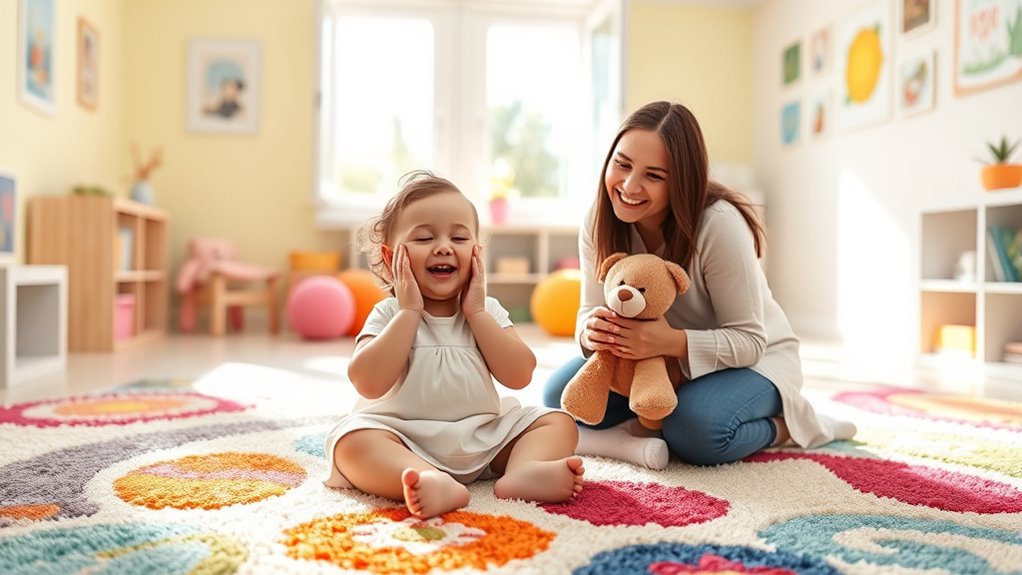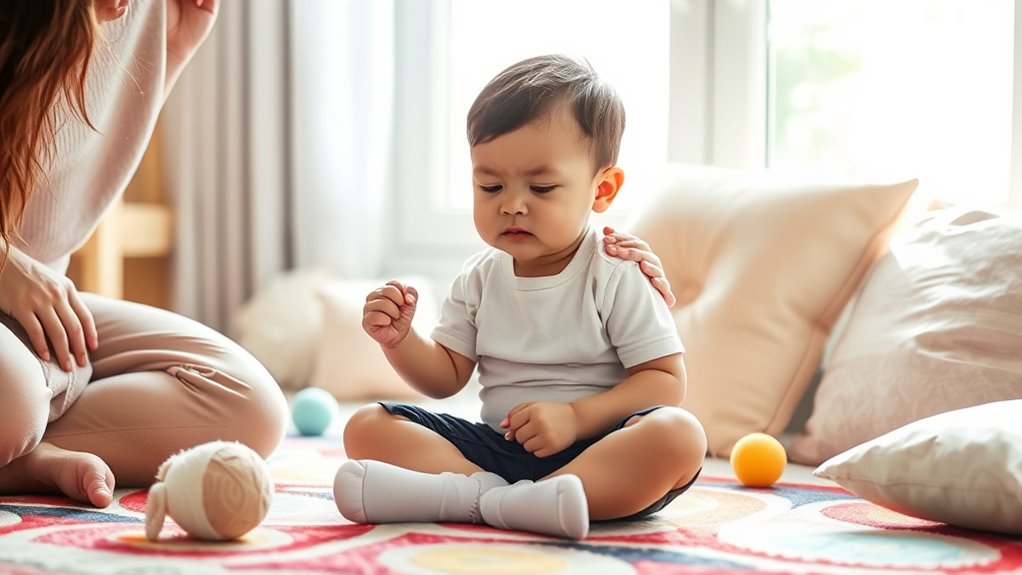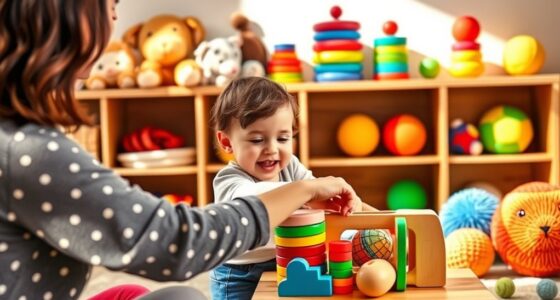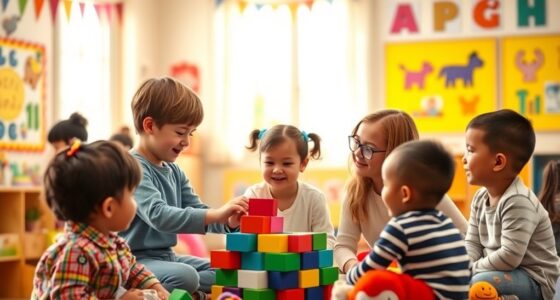Teaching emotional regulation skills to toddlers and young kids is essential for their growth. You can help them recognize and manage feelings by encouraging mindfulness exercises, like deep breathing or noticing sounds around them. Using calming strategies such as a gentle voice or a cozy calm-down corner can also help during emotional moments. Remember, patience and consistency build confidence in these skills. Keep exploring ways to support your child’s emotional health for a stronger, more resilient future.
Key Takeaways
- Teach toddlers mindfulness exercises like deep breathing and noticing sounds to increase emotional awareness.
- Use calming strategies such as gentle words, soft touches, and calm-down corners during emotional outbursts.
- Practice patience and consistency to help children learn and reinforce emotional regulation routines.
- Create a predictable environment with routines that reduce overwhelm and support emotional stability.
- Model calm behavior and provide praise to encourage the development of emotional regulation skills.

Emotional regulation skills are essential for managing your feelings effectively and maintaining mental well-being. As a parent or caregiver, you play a crucial role in helping your little one develop these skills early on. One effective way to do this is by teaching them simple mindfulness exercises. These exercises help children become more aware of their emotions and encourage them to stay present in the moment. For example, you can guide your child to take deep breaths, notice how their chest rises and falls, or focus on the sounds around them. Incorporating mindfulness into daily routines can help your child recognize when they’re feeling overwhelmed and prevent their emotions from escalating.
Calming strategies are another indispensable tool in emotional regulation. When your child is upset or frustrated, teaching them calming techniques can help soothe their distress. You might try using a calm voice and gentle touch, or encouraging them to count to ten slowly. Creating a calm-down corner in your home equipped with soft pillows, stuffed animals, or calming visuals can give your child a safe space to regain control over their feelings. Consistently practicing these calming strategies helps your child associate certain actions with feeling safer and more centered during emotional outbursts.
It’s important to remember that children, especially toddlers and young kids, are still learning how to navigate their emotions. Your patience and consistency are key. When your child experiences strong feelings, acknowledge their emotions without judgment. Saying things like, “I see you’re feeling angry,” helps them understand their emotions are valid. Then, gently introduce mindfulness exercises or calming strategies, guiding them through the process. Over time, these practices become familiar routines, and your child will start to use them independently.
Creating a predictable environment also supports emotional regulation. When children know what to expect, they feel more secure and are less likely to become overwhelmed. Incorporate calming strategies into daily activities, like bedtime routines or transitions between activities, so they become part of your child’s normal rhythm. Reinforcing these skills with praise and encouragement builds their confidence in managing emotions.
Ultimately, your involvement in teaching mindfulness exercises and calming strategies empowers your child to handle their feelings more effectively. These skills will serve them well as they grow, helping them develop resilience and emotional intelligence. By fostering a supportive environment and modeling calm behavior yourself, you set a strong foundation for your child’s emotional health. Remember, patience and consistency are your best tools in guiding your young child toward better emotional regulation. Additionally, understanding emotional regulation as a fundamental skill can motivate you to stay committed to practicing these techniques regularly.
Frequently Asked Questions
How Early Can Toddlers Start Learning Emotional Regulation?
You can start helping your toddler develop emotional regulation skills as early as 12 to 18 months. During this time, they reach early milestones in emotional awareness, like recognizing basic feelings and reacting appropriately. By consistently talking about emotions, modeling calm behavior, and offering comfort, you support their growth. Remember, even young children benefit from gentle guidance, which helps build a strong foundation for managing emotions as they grow.
What Signs Indicate a Child Struggles With Emotional Regulation?
You’ll notice if your child struggles with emotional regulation when tantrum triggers seem to set off endless, unstoppable meltdowns. They might have extreme reactions, difficulty calming down, or show little emotional awareness of their feelings. If tantrums are frequent, intense, or last a long time, it’s a sign they’re having trouble managing emotions. These signs suggest your child needs help developing skills to understand and control their feelings.
Are There Specific Activities That Help Develop Emotional Skills?
You can help develop emotional skills by engaging your child in activities that promote emotion recognition and coping strategies. Use games like matching facial expressions to feelings or storytelling to discuss emotions. Encourage them to identify their own feelings and suggest coping strategies like deep breathing or counting. These activities boost their understanding of emotions, build resilience, and foster healthy regulation skills, making it easier for them to manage their feelings confidently.
How Can Parents Model Good Emotional Regulation?
You can model good emotional regulation through parent-child communication by openly sharing your feelings and handling them calmly. Show emotional modeling by demonstrating patience, empathy, and problem-solving during stressful moments. When you express your emotions thoughtfully, your child learns to do the same. This consistent behavior teaches them healthy ways to manage emotions, strengthening your bond and fostering their emotional development. Your example is key to their growth.
When Should Parents Seek Professional Help for Emotional Regulation Issues?
You should seek professional intervention if your child’s emotional regulation issues persist despite consistent support. Look for signs like intense, ongoing tantrums, difficulty calming down, or avoiding social interactions. An emotional assessment can identify underlying concerns, guiding targeted strategies. Don’t hesitate to consult a mental health professional or pediatric specialist if you notice these signs, as early intervention can make a significant difference in helping your child develop healthier coping skills.
Conclusion
Remember, teaching emotional regulation is like planting seeds in a garden. With patience and consistent care, those tiny sprouts grow into strong, resilient trees that weather any storm. As you guide your child, you’re nurturing their inner landscape—helping them harness the winds of frustration and the sunshine of joy. Over time, they’ll learn to stand tall, rooted in calm and understanding, ready to face life’s seasons with grace and strength.









